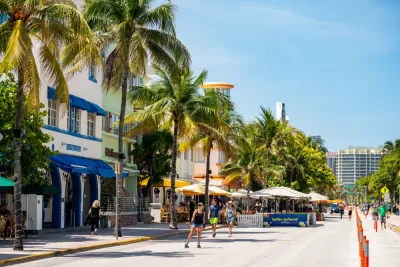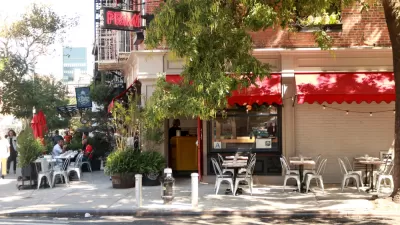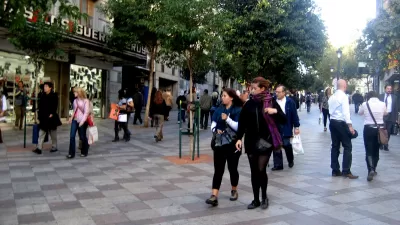The famous cruising strip was off-limits to cars during the pandemic. Now, the city is letting vehicles return with some pedestrian-oriented compromises.

"Like many cities around the world, Miami Beach responded to the Covid-19 crisis by transforming what was once a busy thoroughfare into a car-free space, allowing walkers, bikers and rollerbladers to roam free, and restaurants to expand their outdoor seating offerings." But starting January 24, the city will bring back one-way traffic on a ten-block portion of Ocean Drive, but with some pedestrian-friendly adjustments, reports Sarah Holder. The city is adding two-way bike lanes and keeping one block pedestrian-only.
The transformation of Ocean Drive into a 'slow street' drew both praise and criticism from locals, some of whom expressed the usual complaints about loss of parking and diverted traffic. Yet dire predictions about damage to the strip's vibrant restaurant, nightclub, and luxury car rental industry have not been borne out. In fact, Holder writes, "Resort taxes on food, beverages and room rentals each month of this fiscal year and several months of last have been higher than even pre-pandemic revenues, according to city data published in December 2021." Daniel Ciraldo, executive director of the Miami Design Preservation League, attributes the rise in revenue to the increase in people walking—and noticing businesses—on the street.
As cities begin to dismantle or adapt pandemic-era open streets programs, Miami is developing a long-term plan to prioritize pedestrians on Ocean Drive and the rest of South Beach, increase open space, and allow limited car access to accommodate local needs.
FULL STORY: Miami Beach’s Ocean Drive Revs Up for a Car Comeback

Alabama: Trump Terminates Settlements for Black Communities Harmed By Raw Sewage
Trump deemed the landmark civil rights agreement “illegal DEI and environmental justice policy.”

Planetizen Federal Action Tracker
A weekly monitor of how Trump’s orders and actions are impacting planners and planning in America.

Why Should We Subsidize Public Transportation?
Many public transit agencies face financial stress due to rising costs, declining fare revenue, and declining subsidies. Transit advocates must provide a strong business case for increasing public transit funding.

Understanding Road Diets
An explainer from Momentum highlights the advantages of reducing vehicle lanes in favor of more bike, transit, and pedestrian infrastructure.

New California Law Regulates Warehouse Pollution
A new law tightens building and emissions regulations for large distribution warehouses to mitigate air pollution and traffic in surrounding communities.

Phoenix Announces Opening Date for Light Rail Extension
The South Central extension will connect South Phoenix to downtown and other major hubs starting on June 7.
Urban Design for Planners 1: Software Tools
This six-course series explores essential urban design concepts using open source software and equips planners with the tools they need to participate fully in the urban design process.
Planning for Universal Design
Learn the tools for implementing Universal Design in planning regulations.
Caltrans
Smith Gee Studio
Institute for Housing and Urban Development Studies (IHS)
City of Grandview
Harvard GSD Executive Education
Toledo-Lucas County Plan Commissions
Salt Lake City
NYU Wagner Graduate School of Public Service





























